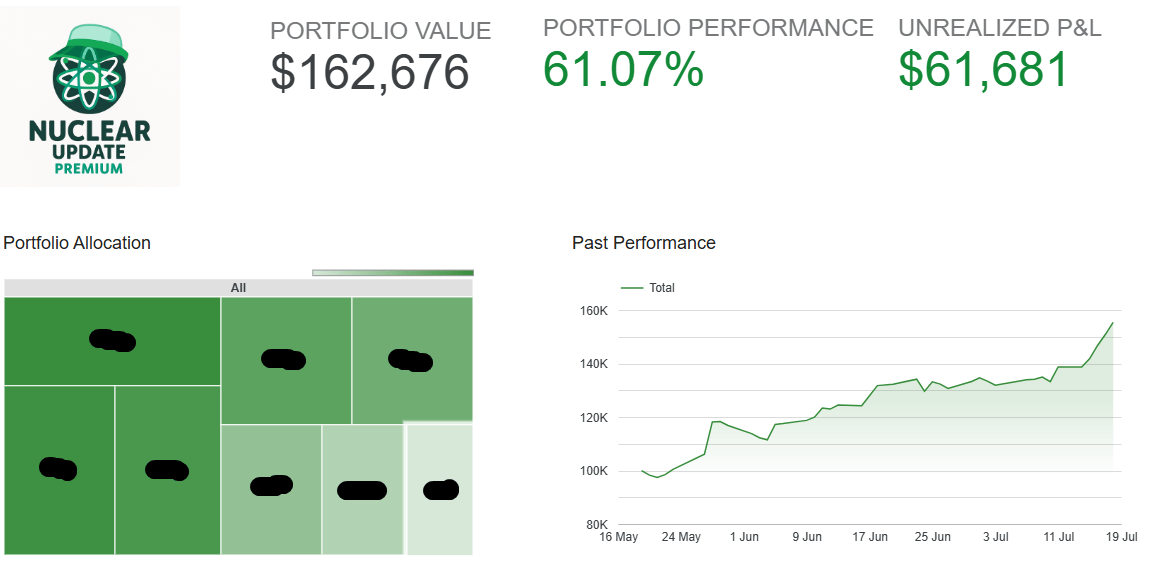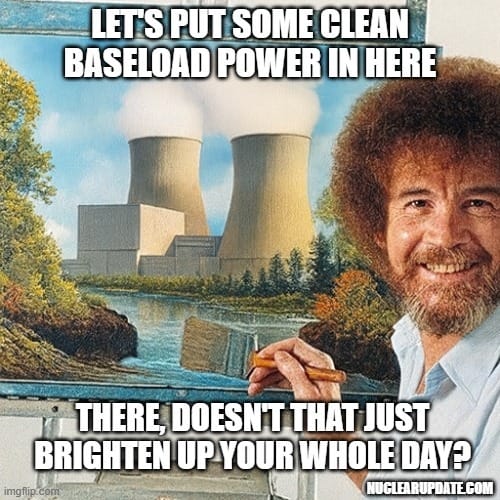- Nuclear Update
- Posts
- 🥳Rolls-Royce to Build 6 SMR in Czechia
🥳Rolls-Royce to Build 6 SMR in Czechia
PLUS: DOE Launches Program to Rebuild Nuclear Supply Chain

Welcome to Nuclear Update, where Newton’s Third Law explains energy markets: every dumb grid policy triggers an equal and opposite price surge.
All jokes aside, it was another HUGE week for nuclear, with wins on both the public and private side, spanning the US, Europe, and Asia.
This is what I got for you this week:
🥳Rolls-Royce to Build 6 SMR in Czechia
🎉DOE Launches Program to Rebuild Nuclear Supply Chain
🌴Thailand Is Going Nuclear
🧬 Neutrons That Solve Crimes
But First; This week’s trivia question:
Where was the first nuclear power plant to supply electricity to the public grid? |
Last week, I asked: What was Uranium originally named after?
You said:
🟩🟩🟩🟩🟩🟩 The Planet Uranus (48%)
⬜️⬜️⬜️⬜️⬜️⬜️ The Ancient City of Ur (5%)
🟨🟨🟨⬜️⬜️⬜️ The Ural Mountains (28%)
🟨🟨⬜️⬜️⬜️⬜️ Ursula, the wife of the discoverer (19%)
Now, let’s dive into the good stuff!💥

🥳Czech Mate: Rolls-Royce to Build 6 SMR in Czechia
The UK just landed its first official export deal for small modular reactors, and it’s not just a win for Rolls-Royce. It’s a geopolitical power play, an industrial policy flex, and a green light for modular deployment in Central Europe.
On July 18, Czech utility ČEZ and Rolls-Royce SMR signed an Early Works Agreement to begin regulatory and site-specific work for new SMR near the Temelín nuclear plant.
Think of it as the opening scene in a much bigger European nuclear reboot.
“Modular reactors are a great opportunity for the Czech economy,” said ČEZ energy chief Tomáš Pleskač.
“A step forward in our shared ambition,” echoed Rolls-Royce SMR CEO Chris Cholerton.
The agreement sets the stage for a multi-phase rollout:
Build the first Czech SMR in the mid-2030s at Temelín
Deliver up to 6 reactors as part of the UK–Czech partnership
Expand to as many as 10 SMRs by 2050
That expansion would add 3 GW of nuclear capacity, exceeding the output of either of Czechia’s current large-scale nuclear plants.
The technology is designed for speed and predictability. The Rolls-Royce SMR is a 470 MW pressurized water reactor (PWR), most of which is factory-built in prefabricated modules. Onsite construction is limited mostly to assembly, cutting risk and compressing timelines. For nations trying to replace coal without a 15-year wait, that’s a major selling point.
But this is more than just a headline. It is a validation moment for SMR deployment.
If Rolls-Royce SMR delivers, it could become the first Western company to export a small modular reactor at commercial scale. That would unlock broader deployment across Europe and position the UK as a serious player alongside NuScale, GE-Hitachi, and South Korea’s KHNP.
It also reinforces that government backing is finally creating predictable pathways for financing, permitting, and construction.
Across Europe, nuclear is being rebranded as clean infrastructure, not legacy baseload. Export-ready SMRs are now seen as a tool for energy security, reindustrialization, and decarbonization all at once.

🎉DOE Launches Program to Rebuild Nuclear Supply Chain
The U.S. just took its biggest step yet toward ending dependence on foreign enriched uranium.
On Friday, the Department of Energy announced a new pilot program to fast-track the development of domestic fuel lines for advanced reactors.
The move is a direct response to Trump’s recent executive orders on nuclear energy, and it signals that the administration is serious about rebooting America’s nuclear backbone, starting with the fuel.
The DOE is now taking applications from U.S. companies to build and operate fuel production facilities under a special authorization framework.
The goal is clear: create a homegrown supply of enriched fuel that can support a wave of next-gen reactor designs without relying on imports from Russia or China.
The pilot program starts with a Request for Applications from companies that are ready to fabricate fuel for use in advanced test reactors.
Applicants will be responsible for everything: construction, operation, decommissioning, and material procurement. The DOE is offering a regulatory fast track, not a funding grant.
The United States no longer has a fully functional domestic fuel cycle. Enrichment capacity is limited. Fabrication lines for advanced fuels like HALEU are patchy at best. And with supply chains still vulnerable to geopolitical shocks, utilities and reactor developers are increasingly worried, if they can build the reactors, where will the fuel come from.
This program is a direct attempt to close that gap. It follows the launch of the DOE’s Reactor Pilot Program last month, which allows advanced reactors to be tested at non-lab sites under Departmental oversight.
For the uranium cycle, this is yet another bullish signal. A domestic enrichment and fabrication push raises the floor on U.S. demand, de-risks supply for advanced reactor developers and aligns perfectly with growing bipartisan momentum around reshoring critical energy infrastructure.
And if there were any doubts about the political tailwinds behind it, just check the tone from the top:
Let’s talk nuclear energy: the energy-dense, always ON energy source that we've smothered for decades with regulatory red tape.
Under the Trump administration, you're going to truly see the launch of the nuclear renaissance.
The coming years will be HUGE.— Secretary Chris Wright (@SecretaryWright)
6:06 PM • Jul 14, 2025
✅America started the nuclear energy industry.
✅We’re the world leader in nuclear generation.
✅We're unleashing American energy for the future.— Office of Nuclear Energy | US Department of Energy (@GovNuclear)
4:20 PM • Jul 14, 2025

🚀 Premium is Growing, So Prices Just Dropped
As more people have joined Nuclear Update Premium, I’m now able to break even at a lower rate, so I’ve dropped the price for everyone (new and existing subscribers).
It’s now $7.70/month or $77/year.
If you’ve been on the fence, this is a good time to hop in. Premium gets you:
Weekly uranium & nuclear market updates
Access to the Nuclear Update Portfolio + deep dives
Insider transactions, cycle signals, and more
The uranium story is just getting started.

Performance since launch: +61.07%

Step inside a real nuclear power plant control room: buttons, buzzers, and all. It’s cooler (and calmer) than you think.👇

🌴 Thailand Is Going Nuclear
The United States and Thailand have officially entered a new phase of strategic energy cooperation as the 123 Agreement, a civil nuclear cooperation pact, entered into force.
This agreement, signed earlier this year by U.S. Ambassador Robert Godec and Thai Minister Supamas Isarabhakdi, reestablishes a formal nuclear framework that had lapsed in 2014.
The previous pact, signed in 1974, lasted 40 years. With this new agreement in place, Thailand is now cleared to access U.S. reactor technologies, nuclear materials, and related equipment for research and civil energy use.
The deal strictly prohibits enrichment and reprocessing, keeping Thailand within global nonproliferation norms.
For Thailand, this opens the door to a clean, reliable energy source that supports long-term emissions goals and helps diversify its grid.
For the U.S., it strengthens a regional alliance, boosts its nuclear industrial base, and supports job creation across both countries.
The U.S. is rapidly expanding nuclear partnerships across Southeast Asia. Singapore signed a 123 Agreement in December, giving it access to U.S. expertise as it explores net-zero pathways.
Malaysia recently signed a memorandum of understanding, laying the groundwork for its own future agreement.
And Vietnam is in talks with Westinghouse to explore reactor deployment and technology transfer.
These partnerships are not only about climate, they are about influence. Washington is using civil nuclear cooperation to build energy alliances, counter strategic competitors, and secure a foothold in the region’s clean energy transition.

⚛️For the Nu-clearly Curious
🏦Bulgaria has secured private funding, from Citi, to build two AP1000 reactors.
Bulgaria has secured a partnership with U.S. bank Citi to finance the construction of 2 reactors at Kozloduy NPP that will use Westinghouse's AP1000 technology.
🌍EU opens door to funding nuclear energy in next budget
The European Commission wants to open up its proposed 2 trillion euro EU budget for 2028-2034 to nuclear energy, which Germany immediately rejected, but is expected to pass anyways.
💻Speaking of Germany; Google pulls plug on planned data center in Berlin, Germany
As reported by Märkische Allgemeine Zeitung (MAZ), Google said that it is withdrawing its plans for the data center "after a thorough review of feasibility, general market developments, and our business priorities." MAZ reports that a factor behind, is the rapid progress of and demand for AI, with power availability in the area not suited to AI compute needs.
🤖Microsoft and the Idaho National Laboratory (INL) has announced a partnership to use artificial intelligence for accelerating the permit process for new nuclear power plants. The collaboration will utilize Microsoft’s AI technology to generate engineering and safety analysis reports required for construction permits and operating licenses for U.S. nuclear facilities.

🧬Neutrons That Solve Crimes
Welcome back to Atomic Alternatives, where we spotlight the unexpected places nuclear tech shows up in the real world.
Today’s setting? A crime scene. And the suspect? Whatever left that microscopic trace behind.
While Hollywood is busy swabbing for DNA, forensic scientists in the real world sometimes reach for something with more punch: neutrons.
Neutron Activation Analysis (NAA) is a nuclear technique that sounds like sci-fi but works like fingerprinting, only you’re scanning atoms, not prints.
🔬 Investigators take a tiny sample, dust, hair, gunpowder residue, and expose it to a neutron source, often inside a research reactor.
💥 The neutrons activate the atoms in the material, making them unstable and radioactive.
As those atoms decay, they emit gamma rays with signatures that reveal exactly what the sample is made of.
Each element has its own gamma-ray fingerprint. That means you can match paint chips to a specific car, or gunshot residue to a specific ammo type, with atomic-level precision.
And the best part? It’s non-destructive. You still have your evidence afterward.
Used by the FBI and crime labs around the world, NAA has helped solve cold cases, ID explosives, and pin down suspects when other methods fell short.
Think CSI, but make it nuclear.

😂Meme of The Week

💪Review of the Week

What did you think of this week's email? |
That’s a wrap for this week’s edition. As always, thanks for reading.
If you learned something, laughed once, or now have strong opinions about gamma spectroscopy, consider sharing the newsletter or upgrading to Premium.
Until next time, stay charged, stay curious, and keep glowing 😎
– Fredrik
📬 [email protected]
🔗 nuclearupdate.com
DISCLAIMER: None of this is financial advice. This newsletter is strictly educational and is not investment advice or a solicitation to buy or sell any assets or to make any financial decisions. Please be careful and do your own research
Reply